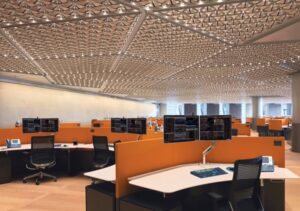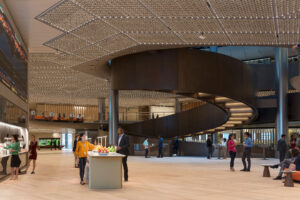As work evolves, it’s crucial to understand the new paradigms shaping our workplaces. Welcome back to our Unworking Weekly mini-series, inspired by new book “Unworking: The Reinvention of the Modern Office” by Philip Ross & Jeremy Myerson.
Over the next twelve weeks, we will explore the themes of each chapter, offering insights into the book’s vision for the future of work and the workplace. For the past century, offices have been integral to society, influencing everything from city architecture to daily routines. However, the pandemic triggered a re-evaluation of the office’s role, promoting a shift away from outdated practices.
Each chapter of Unworking explores the various facets of the evolving workplace landscape. For this week’s blog, we look at Chapter 3: Networks. This chapter explores how interconnected systems and advanced technologies are reshaping how we work, emphasising the importance of networks in creating efficient, collaborative, and innovative work environments.
Network, in the context of work and the workplace, refers to the interconnected systems, both technological and social, that enable seamless communication, collaboration, and information sharing.
This includes digital networks like intranets and cloud-based platforms, as well as physical networks within office spaces that facilitate interaction among employees. A networked workplace leverages these connections to enhance productivity, foster innovation, and support a flexible and dynamic work environment.
The Rise of the Networked Office
Networked offices are transforming traditional workplaces into interconnected hubs of activity. These environments integrate technology to facilitate seamless communication and collaboration among employees, regardless of their location.
The rise of the networked office is driven by several key factors:
- Increased Collaboration: According to a 2018 report by McKinsey, companies that invest in collaborative technologies see a 20-30% increase in productivity.
- Remote Work Integration: A study by Global Workplace Analytics in 2019 reveals that remote work has increased by 173% since 2005, emphasising the need for robust networked systems to support teams no matter the location.
- Enhanced Flexibility: Gartner’s 2021 report found that 82% of company leaders plan to allow employees to work remotely at least some of the time, necessitating networked office solutions that provide flexibility and connectivity.
Deloitte’s Digital Garage in London exemplifies a networked office. Designed to support both in-person and virtual collaboration, it features advanced technological infrastructure connecting teams across the globe. The space encourages innovation and agility, making it a dynamic hub for all of Deloitte’s activities.
Key features of Deloitte’s Digital Garage include:
- Integrated Collaboration Tools: Advanced video conferencing and collaboration platforms that facilitate seamless communication between remote and on-site employees.
- Adaptive Workspaces: Flexible spaces that can be easily reconfigured to support different types of work, from focused individual tasks to collaborative group projects
- High-Speed Connectivity: Robust network infrastructure ensuring reliable and fast internet access, critical for supporting digital work processes and remote connectivity.
By putting these networked office principles into practice, Deloitte’s Digital Garage demonstrates how interconnected systems can enhance productivity, innovation, and employee satisfaction in the modern and ever-changing workplace.

Smart Buildings and Digital Ecosystems
Smart Buildings utilise technology to create efficient, adaptive, and sustainable work environments. These buildings are equipped with sensors and automated systems to optimise energy use, enhance comfort, and support various work styles. By integrating advanced technologies, smart buildings aim to enhance the overall employee experience and productivity while reducing environmental impact.
Bloomberg’s European Headquarters, in London, is renowned for its sustainability and smart building technologies. “The building achieves an ‘Outstanding’ rating against the BREEAM sustainability assessment method, with a 98.5% score. This is the highest design-stage score ever achieved by any major office development.” (Bloomberg, 2017). Designed by Foster + Partners, this building integrates cutting-edge technology to create a comfortable and highly efficient work environment. Key features include:
- Advanced Environmental Controls: The building uses sensors and automated systems to monitor and adjust lighting, temperatures, and ventilation, ensuring optimal comfort for a diverse range of occupants and energy efficiency.
- Energy Efficiency: Being the holder of BREEAM’s Outstanding rating, Bloomberg has achieved this by incorporating a range of energy-saving technologies, such as natural ventilation and rainwater harvesting systems.
- Adaptive Workplaces: The open-plan design and flexible workspaces support various work styles, fostering collaboration and innovation. The building also includes many communal areas and amenities to further enhance employee well-being and productivity.
- Sustainability Initiatives: The headquarters is designed to reduce its environmental impact using sustainable materials, energy-efficient systems, and waste-reduction strategies.
The above initiatives, together, set a benchmark for modern, sustainable workplaces. The building demonstrates how smart technology can create a more efficient, comfortable, and productive work environment, aligning with the principles of a digital ecosystem that supports a diverse range of workstyles, teams, and activities.

Technological Convergence and Cloud Computing
Technological convergence, particularly through cloud computing, enables seamless access to data and applications from everywhere, fostering a more connected and flexible work environment. By using cloud-based solutions, organisations can enhance collaboration, productivity, and scalability while reducing infrastructure costs and increasing accessibility.
Salesforce Tower in San Francisco embodies technological convergence with its state-of-the-art facilities supporting cloud computing and remote work. Designed as a hub for innovation and collaboration, the tower offers a range of amenities tailored to modern work practices.
- Cloud-enabled Infrastructure: The building’s IT infrastructure is built on cloud-based platforms, allowing employees to access applications and data securely from any location with an internet connection.
- Collaborative Workspaces: Salesforce Tower features open-plan workspaces, meeting rooms equipped with advanced video conferencing technology, and communal areas designed to facilitate teamwork and idea sharing.
- Scalability and Flexibility: Cloud computing enables Salesforce to scale its operations rapidly and adapt to changing business needs, providing employees with the tools and resources they need to succeed.
By embracing technological convergence and cloud computing, Salesforce Tower shows us how organisations can leverage digital innovation to create a more connected, efficient, and adaptable workplace.

The concept of networks in the workplace extends beyond digital connections, encompassing the physical and social infrastructure that enables collaboration and innovation. By leveraging advanced technologies and creating interconnected environments, modern workplaces can enhance productivity, foster creativity, and support a dynamic and flexible work culture.
Readers can dive deeper into the exploration of community-oriented workplace design and its impact on the future of work in Philip Ross and Jeremy Myerson’s latest book, Unworking: The Reinvention of the Modern Office. By understanding the rise of the networked office, we can embrace new technologies and interconnected systems, creating dynamic environments that foster flexibility, innovation, and seamless collaboration.
Grab your copy of Unworking from Amazon here.

